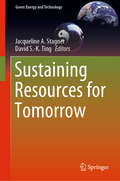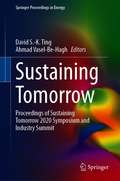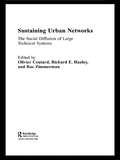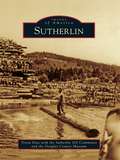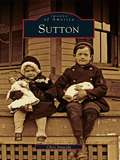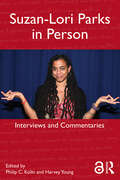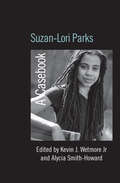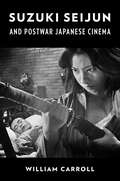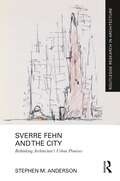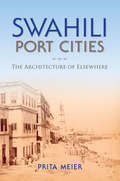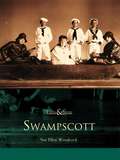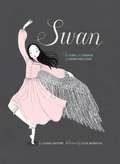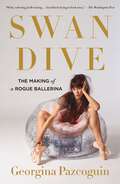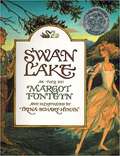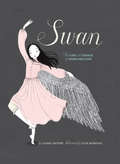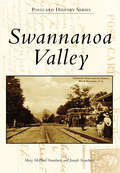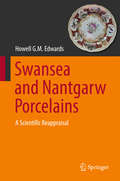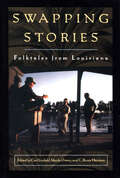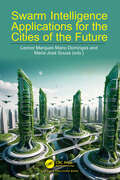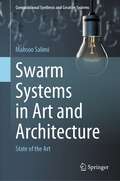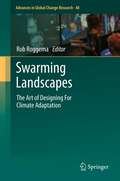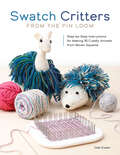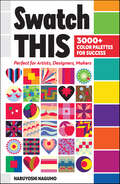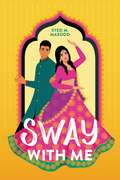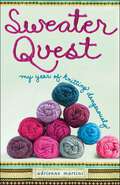- Table View
- List View
Sustaining Resources for Tomorrow (Green Energy and Technology)
by David S.-K. Ting Jacqueline A. StagnerThis book reflects the current state of knowledge on sustainability in a wide range of fields, from engineering to agriculture, to education. Though primarily intended to offer an update for experts and researchers in the field, it can also be used as a valuable educational tool for relevant undergraduate and graduate courses. Key aspects covered include the better and more responsible engineering and management of energy conversion processes, the development of renewable energy technologies, and improvements in conventional energy utilization and food production. In addition, the book addresses green buildings, the green economy, waste and recycling, water, ecopolitics and social sustainability.
Sustaining Tomorrow: Proceedings of Sustaining Tomorrow 2020 Symposium and Industry Summit (Springer Proceedings in Energy)
by David S.-K. Ting Ahmad Vasel-Be-HaghThis book includes the proceedings of the Sustaining Tomorrow 2020 symposium and summit which bring together research from experts in academia, industry, and policy arenas to uncover the challenges and to forge solutions to sustain tomorrow. To sustain tomorrow, we need to continuously make headway in Agriculture, Engineering, Energy, Environment, Economics, Water, among other necessities. This book disseminates the most recent advances in these fields and promotes collaborations to maximize opportunities for innovative solutions.Though primarily intended to offer an update for experts and researchers in the field, this book is equally useful as a valuable educational tool for relevant undergraduate and graduate courses. Key aspects covered include the better and more responsible engineering and management of energy conversion and conservation processes, the furthering of renewable energy technologies, improvements in water-agriculture nexus and energy-environment-economics relationship, and endorsing education, implementation, and evaluation of all-embracing sustainability.
Sustaining Urban Networks: The Social Diffusion of Large Technical Systems (Networked Cities Series)
by Olivier Coutard Rae Zimmerman Richard E. HanleyConsidering sustainability in its economic, environmental and social contexts, the contributors take stock of previous research on large technical systems and discuss their sustainability from three main perspectives: uses, cities, and rules and institutions.
Sutherlin
by Douglas County Museum Tricia Dias Sutherlin 100 CommitteeOriginally called Camas Swale, Sutherlin was incorporated on June 24, 1911, and renamed for Fendel Sutherlin at the behest of his daughter, Anne Sutherlin Waite. What started as an agricultural community of orchard homesites later transitioned into a timber boomtown during World War II. Although the Sutherlin valley had its share of visionaries, most of its people were basic, hardworking folks who persevered despite the roadblocks in their way. They survived floods, fires, destruction of the timber industry by the spotted owl conflict, wholesale unemployment, and the 1989 shutdown of the city for lack of funds. Today's residents are also hardy people, even the newer senior citizens who, in great numbers, are making the town their retirement home.
Sutton
by Chris SinacolaSutton was born among fertile hilltops and well-watered valleys of the Nipmuc country, where, in the early 1700s, a group of London proprietors established a new foothold in America. In the wake of Indian wars, English farmers built a town on their guns, plows, and Congregational sensibilities, a place echoed today through the images in Sutton. No Massachusetts town sent more of its native sons to fight for independence, and Sutton secured that liberty through hard work. French Canadian workers built the mill villages of Manchaug and Wilkinsonville and turned out cloth, hats, and shuttles. Sutton raised prize-winning cattle and grew the Sutton Beauty apple. As the twentieth century brought growth, Sutton blended highways and subdivisions with eighteenth-century homes, farms, and a working blacksmith shop.
Suzan-Lori Parks in Person: Interviews and Commentaries
by Philip C. Kolin Harvey YoungThis collection of interviews offers unprecedented insight into the plays and creative works of Suzan-Lori Parks, as well as being an important commentary on contemporary theater and playwriting, from jazz and opera to politics and cultural memory. Suzan-Lori Parks in Person contains 18 interviews, some previously untranscribed or specially undertaken for this book, plus commentaries on her work by major directors and critics, including Liz Diamond, Richard Foreman, Bonnie Metzgar and Beth Schachter. These contributions combine to honor the first African American woman to receive the Pulitzer Prize in drama, and explore her ideas about theater, history, race, and gender. Material from a wide range of sources chronologically charts Parks’s career from the 1990s to the present. This is a major collection with immediate relevance to students of American/African-American theater, literature and culture. Parks’s engaging voice is brought to the fore, making the book essential for undergraduates as well as scholars.
Suzan-Lori Parks: A Casebook (Casebooks on Modern Dramatists)
by Kevin J. Wetmore Jr Alycia Smith-HowardSuzan-Lori Parks confirmed herself as one of the most exciting and successful playwrights of her generation when her work Topdog/Underdog was awarded the 2002 Pulitzer Prize, making her the only African American woman to win the award. Despite the cultural weight of this achievement, Parks remains difficult both to pigeonhole and to summarize. This volume seeks to provide a context for her work, with essays from major and emerging scholars addressing the importance of factors such as gender, ethnicity, language and history in plays from her first major work, Imperceptible Mutabilities of the Third Kingdom to the 365 Days / 365 Plays project. Suzan-Lori Parks: A Casebook represents the first major study of this unique voice in contemporary drama. Contributors: Leonard Berkman, Jason Bush, Shawn Marie-Garrett, Andrea Goto, Heidi Holder, Barbara Ozieblo, Kevin J. Wetmore Jr and Harvey Young. Kevin J. Wetmore Jr is Professor of Theatre at Loyola Marymount University, as well as being a professional actor and director of the Comparative Drama Conference. He is the author of The Athenian Sun in an African Sky and Black Dionysus: Greek Tragedy and African American Theatre. Alycia Smith-Howard an Assistant Professor at New York University in the Gallatin School of Individualized Study, where she is the Artistic Director of the Gallatin Arts Festival and the Book Reviews Editor at the New England Theatre Journal. A Fellow of the Folger Shakespeare Library, her areas of specialization include Shakespeare, performance history, feminist theatre aesthetics and literature and drama of the south.
Suzuki Seijun and Postwar Japanese Cinema
by William CarrollIn 1968, Suzuki Seijun—a low-budget genre filmmaker known for movies including Branded to Kill, Tokyo Drifter, and Youth of the Beast—was unceremoniously fired by Nikkatsu Studios. Soon to be known as the “Suzuki Seijun Incident,” his dismissal became a cause for leftist student protestors and a burgeoning group of cinephiles to rally around. His films rapidly emerged as central to debates over politics and aesthetics in Japanese cinema.William Carroll offers a new account of Suzuki’s career that highlights the intersections of film theory, film production, cinephile culture, and politics in 1960s Japan. Carroll places Suzuki’s work between two factions that claimed him as one of their own after 1968: the New Left and its politicized theoretical practice on one hand, and the apparently apolitical cinephiles and their formalist criticism on the other. He considers how both of these strands of film theory shed light on the distinctive qualities of Suzuki’s films, and he explores how both Suzuki’s works and unheralded Japanese film theorists offer new ways of understanding world cinema.This book presents both a major reinterpretation of Suzuki’s work—which influenced directors such as John Woo, Jim Jarmusch, and Quentin Tarantino—and a new lens on postwar Japanese film culture and industry. Suzuki Seijun and Postwar Japanese Cinema also includes a complete production history of Suzuki’s filmography along with never-before-discussed information about his unfinished film projects.
Sverre Fehn and the City: Rethinking Architecture’s Urban Premises (Routledge Research in Architecture)
by Stephen M. AndersonThe urban attentions of Pritzker Laureate Sverre Fehn (1924–2009) are extensive, but as yet virtually unexplored. This book examines ten select projects to illuminate Fehn’s approach to the city, the embodiment of that thinking in his designs, and the broader lessons those efforts offer for better understanding the relationship between architecture and urban life, with unignorable implications for emergent urban architecture and its address of sociological and ecological crises. Wary of large-scale planning proposals or the erasure of existing urban patterns, Fehn offered an uncommon and profoundly vibrant approach to urbanism at the scale of the single architectural project. His writings, constructed buildings, competition entries, and lectures suggest opportunities for reinvigorating architecture’s engagement with the city, and provoke a rethinking of concepts foundational to its theorization. What is the nature of urbanity? What is the relationship of urbanity to the natural world? What is the role of architecture in the provision and sustenance of urban life? While exploring this territory will expand our knowledge of an architect central to key developments of late modernism, the range of the book and the arguments developed therein delineate far broader aims: a fuller understanding of architecture’s urban promise.
Swahili Port Cities
by Sandy Prita MeierOn the Swahili coast of East Africa, monumental stone houses, tombs, and mosques mark the border zone between the interior of the African continent and the Indian Ocean. Prita Meier explores this coastal environment and shows how an African mercantile society created a place of cosmopolitan longing. Meier understands architecture as more than a way to remake local space. Rather, the architecture of this liminal zone was an expression of the desire of coastal inhabitants to belong to places beyond their homeports. Here architecture embodies modern ideas and social identities engendered by the encounter of Africans with others in the Indian Ocean world.
Swampscott (Then and Now)
by Sue Ellen WoodcockAs the gateway to the North Shore, Swampscott became one of the most popular summer resorts of the nineteenth and twentieth centuries. Beyond the grand hotels, however, was a town by the ocean, where some derived their income from the sea and others sought the spirit of entrepreneurship and invention. Swampscott was incorporated in 1852 after breaking away from the city of Lynn. Connecting the past and present through a variety of images, Then & Now: Swampscott takes a look at foundations laid by our forefathers, the people who shaped the town and its legends. Whether it is General Electric cofounder Elihu Thomson, Chicago Bears coach Dick Jauron, or the New Ocean House, the collection of images in Then & Now: Swampscott is sure to make you look at the town in a different light and remember those who made the town what it is today.
Swan
by Laurel Snyder Julie MorstadThe world is big.Anna is small.The snow is everywhere and all around.But one night . . .One night, her mother takes her to the ballet, and everything is changed. Anna finds a beauty inside herself that she cannot contain.So begins the journey of a girl who will one day grow up to be the most famous prima ballerina of all time, inspiring legions of dancers after her: the brave, the generous, the transcendently gifted Anna Pavlova. Beautiful, inspirational, and triumphant, Anna Pavlova's life is masterfully captured in this exquisite picture book.
Swan Dive: The Making of a Rogue Ballerina
by Georgina Pazcoguin"Don't expect just tulle and toe shoes. In this fascinating insider's tale, NYCB dancer Pazcoguin reveals her world. . . . A striking debut." —PeopleAward-winning New York City Ballet soloist Georgina Pazcoguin, aka the Rogue Ballerina, gives readers a backstage tour of the real world of elite ballet—the gritty, hilarious, sometimes shocking truth you don’t see from the orchestra circle.In this love letter to the art of dance and the sport that has been her livelihood, NYCB’s first Asian American female soloist Georgina Pazcoguin lays bare her unfiltered story of leaving small-town Pennsylvania for New York City and training amid the unique demands of being a hybrid professional athlete/artist, all before finishing high school. She pitches us into the fascinating, whirling shoes of dancers in one of the most revered ballet companies in the world with an unapologetic sense of humor about the cutthroat, survival-of-the-fittest mentality at NYCB. Some swan dives are literal: even in the ballet, there are plenty of face-plants, backstage fights, late-night parties, and raucous company bonding sessions.Rocked by scandal in the wake of the #MeToo movement, NYCB sits at an inflection point, inching toward progress in a strictly traditional culture, and Pazcoguin doesn’t shy away from ballet’s dark side. She continues to be one of the few dancers openly speaking up against the sexual harassment, mental abuse, and racism that in the past went unrecognized or was tacitly accepted as par for the course—all of which she has painfully experienced firsthand.Tying together Pazcoguin’s fight for equality in the ballet with her infectious and deeply moving passion for her craft, Swan Dive is a page-turning, one-of-a-kind account that guarantees you'll never view a ballerina or a ballet the same way again.
Swan Lake
by Margot Fonteyn Trina HymanA prince's love for a swan queen overcomes an evil sorcerer's spell in this fairy tale adaptation of the classic ballet.
Swan: The Life and Dance of Anna Pavlova
by Laurel SnyderThe world is big.Anna is small.The snow is everywhere and all around.But one night . . .One night, her mother takes her to the ballet, and everything is changed. Anna finds a beauty inside herself that she cannot contain.So begins the journey of a girl who will one day grow up to be the most famous prima ballerina of all time, inspiring legions of dancers after her: the brave, the generous, the transcendently gifted Anna Pavlova. Beautiful, inspirational, and triumphant, Anna Pavlova's life is masterfully captured in this exquisite picture book.
Swannanoa Valley
by Joseph Standaert Mary Mcphail StandaertThe Swannanoa Valley lies to the east of Asheville, North Carolina, and is surrounded by some of the highest mountains in the eastern United States. The eastern boundary of the valley follows the crest of the Blue Ridge Mountains, and travelers entering through the Swannanoa Gap emerge into the beautiful "Land of the Sky." In the 1900s, multiple large religious assemblies were founded here. Montreat, Ridgecrest, the YMCA Blue Ridge Assembly, and Christmount have preserved thousands of acres of forested mountain slopes for more than a century. The valley is drained by the Swannanoa River, which meanders 18 miles westward, finally merging with the French Broad River near Biltmore. Swannanoa Valley showcases the rich recreational and cultural history of this scenic mountain area.
Swansea and Nantgarw Porcelains
by Howell G.M. EdwardsThis book describes a holistic study of the porcelain manufactured at Nantgarw and Swansea in the first quarter of the 19th Century, using both scientific analytical data and historical provenancing. This porcelain is acclaimed as some of the finest and most translucent porcelain ever produced. These two porcelain factories are linked through the artistic and creative activities of the enigmatic William Billingsley and had a strictly limited production over only three or four years during the period 1812-1820. The earliest chemical analysis of these porcelains were undertaken almost 100 years ago and are compared with the results of more recent analyses The chemical composition of these porcelains, their artistic decoration and the struggle to maintain quality production is reviewed. Scientific explanations are proposed for the characteristic Swansea duck-egg porcelain translucency and for the Nantgarw iridescence. The book is well illustrated throughout and affords a good basis for the further in-depth study of Swansea and Nantgarw porcelains.
Swapping Stories: Folktales from Louisiana
by Carl Lindahl Maida Owens C. Renée HarvisonHere are more than two hundred oral tales from some of Louisiana's finest storytellers. In this comprehensive volume of great range are transcriptions of narratives in many genres, from diverse voices, and from all regions of the state.Told in settings ranging from the front porch to the festival stage, these tales proclaim the great vitality and variety of Louisiana's oral narrative traditions. Given special focus are Harold Talbert, Lonnie Gray, Bel Abbey, Ben Guiné, and Enola Matthews—whose wealth of imagination, memory, and artistry demonstrates the depth as well as the breadth of the storyteller's craft. For tales told in Cajun and Creole French, Koasati, and Spanish, the editors have supplied both the original language and English translation. To the volume Maida Owens has contributed an overview of Louisiana's folk culture and a survey of folklife studies of various regions of the state. Car Lindahl's introduction and notes discuss the various genres and styles of storytelling common in Louisiana and link them with the worldwide are of the folktale.
Swarm Intelligence Applications for the Cities of the Future
by Maria José Sousa Leonor Marques Mano DomingosThis book explores the transformative power of swarm intelligence and digital innovations in shaping the cities of the future. It presents a comprehensive analysis of how social learning, citizen engagement, advanced technology, design, construction, planning and public policies converge to create cities that are sustainable, resilient, and inclusive.The initial chapters stress the importance of collective intelligence in urban development, using technologies like Virtual Reality to increase citizen participation and democratise decision-making. Public policies play a key role in driving the digital transformation needed for greener cities, with frameworks and tools to enhance transparency and accountability. Digital technologies in policymaking ensure that policies are adaptive, data-driven, and responsive to real-time challenges. Internet of Things systems are explored for their role in improving public safety, urban resilience, and energy efficiency through digital twins, blockchain, and sensor networks. Swarm intelligence is highlighted for optimising energy management, reducing consumption, and promoting renewable resources. Healthcare integration into urban planning and sustainability is also discussed, with a comparative analysis of cities showing how tech innovation enhances resilience against climate change. Swarm intelligence beyond cities is also explored, such as for disaster response, healthcare, environmental conservation, and agriculture. Autonomous systems like drones and nanobots are shown to improve efficiency across various sectors.Overall, this book advocates for a holistic approach to urban development, integrating digital technologies and collective intelligence to create cities that are technologically advanced, socially equitable, and environmentally sustainable.
Swarm Systems in Art and Architecture: State of the Art (Computational Synthesis and Creative Systems)
by Mahsoo SalimiThis book presents the recent computational developments inspired by swarms in art known as swarm art and discusses applying swarm intelligence concepts in architecture. Non-human art is a great leap in the evolution of contemporary art, removing the requirement of an artist’s production from the creative process. Furthermore, it is a critical declaration in opposition to the anthropomorphic vision which is so destructive for all other life forms and the planet’s ecology. When accepted and integrated into human culture, non-human art done by artificial systems or machines boosts creativity and stimulates innovative fusions. We analyze 120 swarm systems with unique and diverse conceptual contexts, agent design, and audience engagement that can be utilized as inspiration for future projects or to design new swarm algorithms by artists, architects, or computer scientists.
Swarming Landscapes
by Rob RoggemaThis book advocates a fresh approach to planning that anticipates, rather than reacts to, the changes in climate currently in process. Today's spatial planning procedures rely on historical evidence instead of preparing for factors that by definition lie in the future, yet which are relatively uncontroversial: shortages of water, sea level rise and rises in average temperatures being but three examples. Arguing for more flexibility, the contributors view 'complexity' as the key to transforming the way we plan in order to better equip us to face uncertainties about our future environment.
Swatch Critters from the Pin Loom: Step-by-Step Instructions for Making 30 Cuddly Animals from Woven Squares
by Deb EssenLearn how to transform woven squares into a charming collection of stuffed animals with this fun and accessible project book. Using basic fiber art skills and a handy pin loom, makers will learn how to combine simple woven squares to create 30 adorable critters, from dogs and cats to dinosaurs and hedgehogs. With step-by-step instructions and tips on color changing, weaving patterns, and mastering twill techniques, this guide unlocks the creative potential of pin loom weaving, letting artisans turn their leftover swatches into delightful, cuddly companions. Whether enjoyed by seasoned fiber artists or beginning weavers, this book makes it easy to bring woven squares to life in a fun and creative way.
Swatch This: 3000+ Color Palettes for Success
by Haruyoshi NagumoChoose color combinations confidently every time! Expand your color confidence with a comprehensive dictionary of color combinations! Color combinations are made simple with this helpful reference that includes endless numbers of color palettes for artists to perfect their color selection every time. Every color you want to experiment with, from the colors of the rainbow to pastels, neons, metallics, and more are included in inspirational mood boards and color recipes. Your “color recipes” show numerous combinations “in action” using digital swatches designed for artists in every field. Gain a unique understanding of how to swatch colors and achieve success every time. Expand your color confidence with this easy-to-use reference Color recipes that show numerous combinations of colors “in action” using digital swatches Includes colors usually not shown in combinations including gold, silver, and neons
Sway with Me
by Syed M. MasoodShe&’s All That goes desi in this hilarious, affecting, and sweetly romantic comedy by the author of More Than Just a Pretty Face.Arsalan has learned everything he knows from Nana, his 100-year-old great-grandfather. This includes the fact that when Nana dies, Arsalan will be completely alone in the world, except for his estranged and abusive father. So he turns to Beenish, the step-daughter of a prominent matchmaker, to find him a future life partner. Beenish&’s request in return? That Arsalan help her ruin her older sister&’s wedding with a spectacular dance she&’s been forbidden to perform.Despite knowing as little about dancing as he does about girls, Arsalan wades into Beenish&’s chaotic world to discover friends and family he never expected. And though Arsalan&’s old-school manners and Beenish&’s take-no-prisoners attitude clash every minute, they find themselves getting closer and closer—literally. All that&’s left to realize is that the thing they both really want is each other, if only they can get in step.At turns laugh-out-loud funny, poignant, and sincerely heartfelt, Sway With Me is a coming-of-age story for anyone trying to find their place in the world.
Sweater Quest: My Year of Knitting Dangerously
by Adrienne Martini"I knit so I don’t kill people" —bumper sticker spotted at Rhinebeck Sheep and Wool Festival For Adrienne Martini, and countless others, knitting is the linchpin of sanity. As a working mother of two, Martini wanted a challenge that would make her feel in charge. So she decided to make the Holy Grail of sweaters—her own Mary Tudor, whose mind-numbingly gorgeous pattern is so complicated to knit that its mere mention can hush a roomful of experienced knitters. Created by reclusive designer Alice Starmore, the Mary Tudor can be found only in a rare, out-of-print book of Fair Isle–style patterns, Tudor Roses, and requires a discontinued, irreplaceable yarn. The sweater, Martini explains, "is a knitter’s Mount Everest, our curse, and our compulsion. I want one more than I can begin to tell you." And so she took on the challenge: one year, two needles, and countless knits and purls to conquer Mary Tudor while also taking care of her two kids, two cats, two jobs, and (thankfully) one husband—without unraveling in the process. Along the way, Adrienne investigates the tangled origins of the coveted pattern, inquires into the nature of artistic creation, and details her quest to buy supplies on the knitting black market. As she tries not to pull out her hair along with rows gone wrong, Martini gets guidance from some knitterati, who offer invaluable inspiration as she conquers her fear of Fair Isle. A wooly Julie and Julia, this epic yarn celebrates the profound joys of creating—and aspiring to—remarkable achievements.
